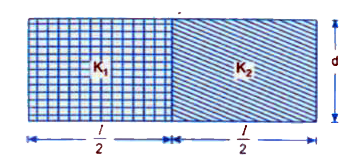A parallel plate capacitor has capacitance C. If it is equally filled with parallel layers of materials of dielectrics K1 and K2 — Solution in Bengali
k1+k2
K1K2K1−K2
K1+K2K1K2
2K1K2K1+K2
Step by step video & image solution for A parallel plate capacitor has capacitance C. If it is equally filled with parallel layers of materials of dielectrics K_1 and K_2 — by Physics experts to help you in doubts & scoring excellent marks in Class 12 exams.
Updated on:21/07/2023Topper's Solved these Questions
Similar Questions
The total flux ϕcomes out of a sphere of radius r. Keeping the amount of charge constant, if the radius of the sphere is made 2r, how much flux will come out of the sphere now?—
View SolutionThree charges each of +1μC are placed at the comers of an equilateral triangle. If the force between any two changes be F,then the net force on either change will be —
View SolutionThe space between the plates of a parallel plate capacitor of capacitance C is filled with three dielectric slabs of identical siza as shown in figure. If the dielectric constants of the three slabs are K1,K2andK3 find the new capacitance.

View SolutionA parallel plate capacitor of area A, plate separation d and capacitance C is filled with three different dielectric materials having dielectric constants k1, k2 and k3 as shown. If a single dielectric material is to be used to have the same capacitance C in this capacitor, then its dielectic constant k is given by

View SolutionThe capacitance of a parallel plate capacitor with plate area A and separation d is C. The space between the plates in filled with two wedges of dielectric constants K1 and K2 respectively. Find the capacitance of resulting capacitor.

View Solutionएक समांतर प्लेट संधारित्र की प्लेटों के बिच दो प्रावधूत गुके ( जिनके प्राविधुतनक क्रमशः K1 तथा K2 है ) चित्र में दर्शाये अनुसार भरे हुए है | संधारित्र की धारिता क्या होगी ?

View Solutionसमानान्तर प्लेट संधारित्र के प्लेटों के बीच परावैद्युत पदार्थ डालने पर संधारित्र की धारिता
View SolutionA parallel plate capacitor of area A, plate separation d and capacitance C is filled with three different dielectric materials having dielectric constants k1k2andk3 as shown in the following figure. If a single dielectric material is to be used to have the same capacitance C in this capacitor then its dielectric constant k is given by

View SolutionThe area A of a parallel plate capacitor is divided into two equal, halves and filled with two media of dielectric constants K1andK2 respectively. The capacitance of the capacitor will be

View SolutionTwo dielectric slabs of dielectric constants K1andK2 are filled in between the two plates, each of area A, of the parallel plate capacitor as shown in the figure. Find the net capacitance of the capacitor.

View SolutionThe space between the plates of a parallel plate capacitor of capacitance C is filled with three dielectric slabs of identical size as shown in figure. If the dielectric constants of the three slabs are K1,K2andK3 find the new capacitance.

View SolutionA parallel-plate capacitor of area A, plate separation d and capacitance C is filled with four dielectric materials having dielectric constants k1,k2,k3 and k4 as shown in the figure below. If a single dielectric material is to be used to have the same capacitance C in this capacitor, then its dielectric constant k is given by

View SolutionA parallel plate capacitor of plate area A and separation d filled with three dielectric materials as show in figure. The dielectric constants are K_1 , K_2 and K_3 respectively. The capacitance across AB will be :
View SolutionA parallel plate capacitor of capacitance C (without dielectric) is filled by dielectric slabs as shown in figure. Then the new capacitance of the capacitor is

View SolutionA parallel plate capacitor of area A, plate separation d and capacitance C is filled with three different dielectric materials having dielectric constants k_1 , k_2 and k_3 as shown. If a isngle dielectric material is to be used to have the same capacitance C in this capacitor, then its dielectic constant k is given by
View Solution
